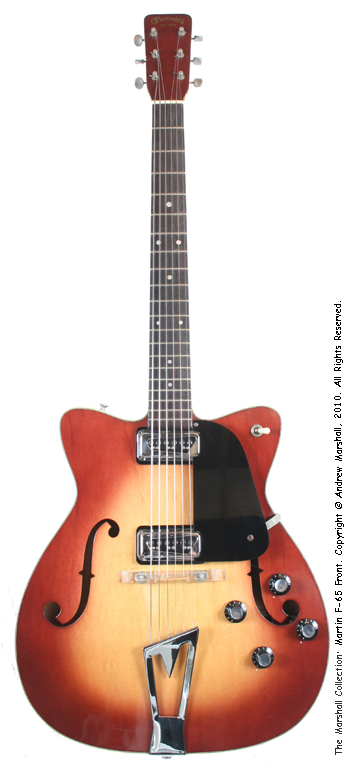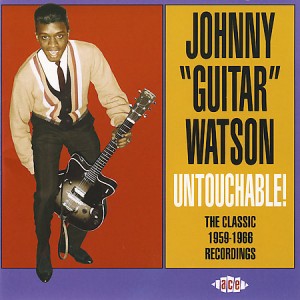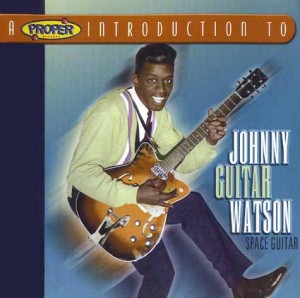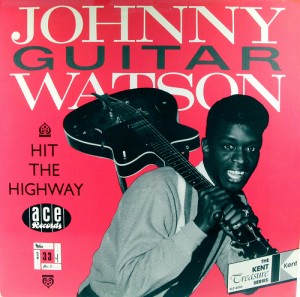The Martin F-Series were Martin’s first true electric guitars, although by no means Martin’s first archtop, the design reminiscent of the F series (non-electric) F-7 and F-9 archtops of the 1930’s.
The series comprised the single pickup, single cutaway F-50, the dual pickup single cutaway F-55, and the double cutaway dual pickup F-65. All models came in a single finish, described by Martin as Honey Burst, and were offered with an optional bigsby tailpiece. The bound body was of a laminate construction, with the finished top being maple. The neck was mahogany with a rosewood fretboard and a traditional Martin headstock and logo with three-per-side tuners, and joined the body at the 14th fret. The F Series were the only Martin to ever use plexiglas bridges, possibly the only guitars ever to do so. (The reason plexiglas was used was that a Martin board member at the time owned a plexiglas factory and was keen to get into the guitar hardware business). All F-Series guitars were built in Nazareth PA.
All models used DeArmond Dynasonic single coil pickups, identical to those used on many other guitars of the period but with a custom chrome cover and bobbin formed to fit the unique cutouts. The pickups were made for DeArmond by Rowe Industries in Toledo OH, and as far as I can determine the offset cutout in the cover is unique to Martin electrics.
The F-55 was also notable in that it was Martin’s first single cutaway guitar. By extension, the F-65 was Martin’s first double cutaway guitar as well. Close examination of the rear of the F-65 in the gallery below will show that the double cutaway was acheived by retaining the body heel to the 14th fret – a creative but somewhat unusual solution to create a double cut.
Typical Martin attention to design detail is clear – the unique pickup cover cutaways and the complementary designs on the tailpiece of both the chrome trapeze of the stop tail and the black panel on the Bigsby tailpiece, the body high visibility dots to show the position of each volume and tone control are just some examples.
The F Series were made between late 1961 and 1965, and followed the normal Martin 6-digit serial number sequence, shared with all other instruments from this period. The serial number can be found (with a little help from a flashlight) inside the upper F-Hole.
From a collectors point of view
Martin fans don’t like these guitars. I mean they really, really don’t like them. To a certain extent, that’s because they’re not acoustics, and Martin makes really, really good acoustics. You will hear opinions up to and including scorn from some experts, and Martin themselves only gives the series a passing nod, and you won’t find very much in either official or unofficial histories about these instruments.
Let’s be honest, the F series will never be up there with pre-CBS stratocasters and 58-60 Les Pauls as collectors pieces, but any early 60’s US manufactured instrument from a major, respected maker that was made in relatively small quantities is collectible. What’s more, they’re still affordable, although the prices are climbing.
All the normal rules apply, original condition is paramount for an F to be collectible. Personally my favorite is the F-55, it plays extremely well, with a jazzy feel and to my eye looks the most balanced.
There is, however, one point to warn would be collectors about: the bridge. All three F-Series models left the factory with a plexiglas moveable bridge assembly, as shown in all the examples on this page. Many examples had those bridges replaced with more traditional wood pieces early on in their careers – if it doesn’t have the plexi bridge, it’s not original.
There are rumors that people latch on to, such as the bigsby equipped versions didn’t have the plexi bridge when they left the factory. Sorry – they all had them. If it hasn’t got it now, it’s been changed, however maybe with good reason. I’ve recently learned (thanks Bud!) from another collector that the plexi bridges frequently failed. String tension caused the bridge to flatten, eliminating the radius. You can see the effect in a picture he provided me here.
Dating and production numbers
Relatively few F-Series instruments were made between 1961 and 1965: just 519 F-50’s, 665 F-55’s and 566 F-65’s. Only 15 of each were made in 1961, with production not getting into full swing until 1962.
| F-50 | F-55 | F-65 | |
| 1961 | 15 | 15 | 15 |
| 1962 | 201 | 325 | 250 |
| 1963 | 125 | 125 | 101 |
| 1964 | 177 | 150 | 125 |
| 1965 | 1 | 50 | 75 |
The three F-50 prototypes were numbered 179828-179830, the three F-55 prototypes were numbered 179831-179833, and the three F-65 prototypes were numbered 179834-179836. This would date the prototypes around the fall of 1961.
The table below shows the start and end serial number for Martins made between 1961 and 1965. This can be used to date the manufacture of F-Series instruments.
| Dating | Start | End |
| 1961 | 175690 | 181297 |
| 1962 | 181298 | 187384 |
| 1963 | 187385 | 193327 |
| 1964 | 193328 | 199626 |
| 1965 | 199627 | 207030 |
In the August 1962 price list, the F-50 listed at $225, the F-55 at $275 and the F-65 at $300, with the Bigsby option adding $55 and a case another $50. In comparison the top-of-the-line flat top of the day, the D-28 was $335 and the D-18 just $210, making the F-65 with Bigsby the most expensive guitar on the price list in 1962.
Gallery
The gallery shows front and back shots of each F series model. Note that the F-50 depicted has faded more dramatically than the F-55 and F-65. F Series instruments show a wide variety of fade variance. Also in the gallery is the August 1962 Martin price list which shows the models, their cases and other useful background.
Speaking of Electric Buitars, CBS Radio Executive Marc Rayfield manages one of my favorite stations in New York! Check it out here.
Who Played these then?
Probably the most well known F series guitarist was Johnny “Guitar” Watson, who played an F-65 with Bigsby in the mid 1960’s. This can be seen in publicity shots of the era, and is featured on at least three album covers:


















I bought my f-50 in 1987 in Portland, OR for $300. It was my 1st electric guitar I ever bought. I also bought a Silvertone 1484 amp head for $200 a few months later. I still have them both and play beautiful together. My bridge base is plexi, but has a metal adjustable bridge replacement on top (it came this way). I always wondered if it was original. Now I know. I played it in my band from the late 80’s to early mid 90’s. Has typical scratches and dings from performing. It sounds best to me with the tone rolled back for that warm jazz tone. I ran across a F-65 w/ Bigsby whammy a few years after I bought the F-50 and considered buying it, but the action not that great compared to mine so I left it behind. I often have regrets about that decision. lol Thanks for the great resource page!
I have a very nice Martin F-65 with serial number 179835. It has an aluminum bridge which looks just like the plexiglass but was hand machined. I have to thank you as I thought this was one of the prototypes. The second to be correct. I also noticed that the 61 Martins started at serial 18**** and the 1960 17****. So not sure but the plexiglass seems to be a bad idea. I believe since mine is a prototype they needed to make one to for the mold. Anyway thanks for the info. I like your site very informative. I have many guitars. Favorite Gretsch Viking with tunning fork. I also like my gibson 3/4 mahogony melody maker. really small and fun to play. Thanks and will check in now and then If you want send me email [email protected] and I will send phone number. I am an engineer and rebuild Amplifiers mostly fenders have my original 1967 Deluxe Reverb and a 67 Pro Reverb same amp but two twelves and 2 6L6 instead ov 6V6. Take care and thanks!
Jon
STEVE –
I’d say you got a great deal, especially with the original bridge. Hard to say about the headstock without seeing a photo. The conventional wisdom is ‘don’t correct blemishes’ as it reduces the originality, but it depends what would need to be done. If you want to post a photo I could probably give you a better idea.
Best
Andrew
bryan – A guitar is ‘worth’ as much as you’re willing to pay for it, as far as I’m concerned. I’d rather pay $5000 for a guitar that I really want and plays well that everyone says is worth $2500 than pay $2500 for a guitar I don’t like that everyone says is worth $5000. If you see what I mean.
And you’re right, they’re not making any more F-50’s any time soon 🙂
The F-50 is a great guitar, hope you enjoy it.
Andrew
I just recently bought an F-50 for $1200. The serial # indicates it is a 1962. The owner kept the original bridge (I have that) but replaced it and also appeared to have put a different pick guard on it. The guitar plays really well and the electrics are all in working order. It is in really good condition except for a mark on the head stock that looks as if it comes from something being glued on there by a previous owner. Do you recommend having this blemish fixed? I intend to keep the guitar.
I’ve got a F50 without the original bridge (didn’t realize that until just now!). I paid about $1,800 for it. Whether or not I “paid too much,” I don’t know. I do know that I play it frequently, and it sounds great. However you slice it, playing a guitar that A. Was made in the heyday of the rock and roll era, B. Is one of only 511 made and C. is a Martin… that almost nobody has… is pretty cool, and well worth $1,800.
Best,
Bryan
Also – can’t help on the acoustic I’m afraid, not my field!
Hi there, value can vary a lot depending on condition, whether it has the original plexiglass bridge and so on. I really wouldn’t like to give a value without seeing the instrument, but a good original F-50 can go for anywhere from $1K to $2K.
My father has a f-55 and is trying to find out what the value of it would be, can you help us? Thank You.